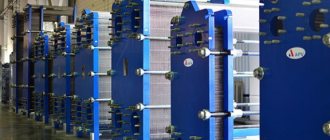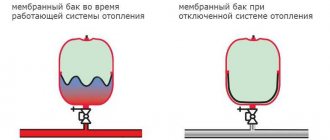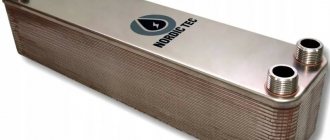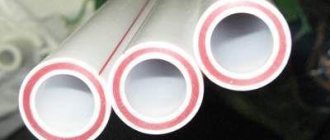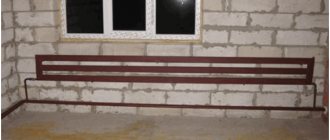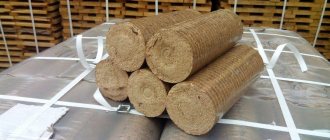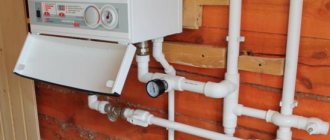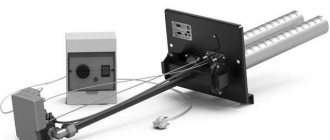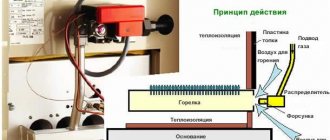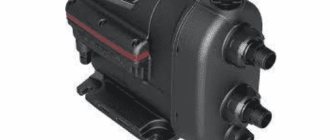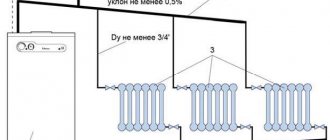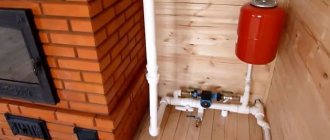If there is only cold water in the house, then living in it can hardly be called comfortable. Often, to solve this problem, it is proposed to install a separate system that will heat the coolant, consuming additional electricity. But if you install a heat exchanger for hot water from heating, you can significantly save energy resources. Let's consider what types of devices are used in private homes, and how they are correctly connected to the heating system.
Plate heat exchanger Source a.allegroimg.com
Heat exchanger features
Let's figure out why a heat exchanger is needed. In the device, two different media share thermal energy. Hot water in one container gives off its temperature to the cold liquid, which moves in another container. And the simplest example is a system of two steel pipes of different diameters.
Cold water moves less. A small section of this pipe is placed in another, larger diameter. The latter contains hot water. And after a short time, the temperatures of both liquids become equal.
In order for the process to proceed steadily and constantly, the water is forced to move (circulate). And giving the flows certain speeds allows you to minimize all heat losses. Moreover, only one energy source is used to heat two systems at once.
This arrangement significantly increases the autonomy of the home. And eliminating unnecessary equipment from operation allows you to be less dependent on network resources. Thereby reducing energy costs in the home.
Stainless steel heat exchanger Source s-ip.com.ua
The performance of the entire system is affected by:
- Device model (design).
- Temperature regime.
- State of the system.
The last point relates to the amount of heat loss. The surface of the pipes through which the liquid moves is responsible for this. If scale has formed on the walls, the heat transfer of the system is significantly reduced. The latter is also influenced by other factors, including simple fat deposits.
In the fight against losses, prevention of blockages and contamination comes first. The heating heat exchanger is equipped with filters that filter out foreign particles and suspension. Also, at certain intervals, the device must be completely cleaned of scale and other deposits. To do this, it is disassembled and washed using special means.
See also: Catalog of companies that specialize in engineering systems (heating, water supply, sewerage and others) and related work
Advantages and disadvantages
The widespread use of plate heat exchangers is due to the following advantages:
- compact dimensions. Due to the use of plates, the heat exchange area significantly increases, which reduces the overall overall dimensions of the structure;
- ease of installation, operation and maintenance. The modular design of the unit makes it easy to disassemble and wash elements that require cleaning;
- high efficiency. PHE productivity ranges from 85 to 90%;
- affordable price. Shell-and-tube, spiral and block installations, with similar technical characteristics, are much more expensive.
The disadvantages of the plate design are:
- need for grounding. Under the influence of stray currents, fistulas and other defects can form in thin stamped plates;
- the need to use high-quality working environments. Since the cross-section of the working channels is small, the use of hard water or low-quality coolant can lead to blockage, which reduces the intensity of heat transfer.
Device classification
Heat exchangers for hot water supply are made of either steel or cast iron. The latter method is more traditional, since not so long ago stainless steel was considered a scarce material. And the use of ordinary metal was unprofitable. Therefore, the system was very quickly damaged by corrosion.
Heat exchanger made of cast iron Source pechiexpert.ru
But even the abundance of modern materials did not exclude the production of cast iron models. After all, their casting is characterized by high speed and extreme simplicity. And today, both conventional cast iron structures and more complex models made of modern steel are equally popular.
Cast iron
A heat exchanger made of this metal has very good performance. And they buy it more for reasons of economy, since its cost is much lower than that of its stainless counterparts. But when purchasing a cast iron structure, you need to be prepared that it has serious disadvantages.
The surface is highly fragile. And any serious blow simply splits it. Cracks can also appear due to thermal exposure. If cold water pressure is applied to a well-heated structure, the walls will most likely not withstand it.
Such damage can no longer be repaired. But otherwise the material is capable of long-term use if treated with care. And it does not require preventive intervention as often as its stainless steel counterparts.
Heat exchanger cassette Source termotactic.ru
Specifications
As a rule, the technical characteristics of a plate heat exchanger are determined by the number of plates and the way they are connected. Below are the technical characteristics of gasketed, brazed, semi-welded and welded plate heat exchangers:
| Operating Parameters | Units | Collapsible | Soldered | Semi-welded | Welded |
| Efficiency | % | 95 | 90 | 85 | 85 |
| Maximum operating temperature | 0C | 200 | 220 | 350 | 900 |
| Maximum working pressure | bar | 25 | 25 | 55 | 100 |
| Maximum power | MW | 75 | 5 | 75 | 100 |
| Average period of operation | years | 20 | 20 | 10 — 15 | 10 — 15 |
Based on the parameters given in the table, the required heat exchanger model is determined. In addition to these characteristics, one should take into account the fact that semi-welded and welded heat exchangers are more suitable for working with aggressive working environments.
Model types
The devices differ in the installation method. And this directly affects the efficiency of the entire system. Very often a boiler design is used that already has a heating heat exchanger inside. Heat losses in such devices are practically reduced to zero. And for productive work all you need is proper configuration.
External structures are much less efficient. Because their position does not allow the coolant to heat up well. But they are used where there are no individual heating boilers. For example, in houses using centralized heating.
How to make a calculation
The calculation for the DHW heat exchanger is made through rather complex calculations that require special training. A detailed calculation requires drawing up a heat balance, taking into account heat transfer devices, calculating the average temperature difference, etc.
All these operations require knowledge in the field of heating engineering, which not everyone has, and the probability of error is very high even for a specialist.
A way out of this situation can be found on the Internet - online calculators, available in sufficient quantities on the websites of heating equipment manufacturers, allow you to obtain the necessary data simply and quite reliably. To check, the calculation should be duplicated several times, the results should be compared to select the most correct one.
System installation
Since the internal heat exchanger is connected to the system at the same time as the heating boiler, only the installation of external devices needs to be considered separately. This operation is not difficult. You just need to check that there is a thread at the inlet and outlet of the device. Otherwise, you will have to take special care in cutting it.
Connecting the heat exchanger to the network requires fixing it to the wall. If a cast iron structure is used, then the fasteners are selected with special strength. It is best to use a special console.
For insertion into the system, specific couplings are used, which will also be needed if there is a desire to provide the structure with additional water filters. In some cases, two of them are installed at once. This arrangement is used for old heating systems.
You will also need standard taps and American ones. The latter consist of two threaded fittings, a gasket and a union nut.
User manual
Each factory plate heat exchanger must be accompanied by detailed operating instructions containing all the necessary information. Below are some basic provisions relevant to all types of VET.
PHE installation
- The location of the unit must provide easy access to the main components for maintenance.
- The fastening of supply and discharge lines must be rigid and airtight.
- The heat exchanger should be installed on a strictly horizontal concrete or metal base with sufficient load-bearing capacity.
Commissioning works
- Before starting the unit, it is necessary to check its tightness according to the recommendations given in the technical data sheet of the product.
- During the initial startup of the installation, the rate of temperature increase should not exceed 250 C/h, and the pressure in the system should not exceed 10 MPa/min.
- The procedure and scope of commissioning work must clearly comply with the list given in the unit’s passport.
Unit operation
- When using PHE, it is not allowed to exceed the temperature and pressure of the working medium. Overheating or increased pressure can lead to serious damage or complete failure of the unit.
- To ensure intensive heat exchange between working media and increase the efficiency of the installation, it is necessary to provide for the possibility of cleaning working media from mechanical impurities and harmful chemical compounds.
- Regular maintenance and timely replacement of damaged elements will significantly extend the service life of the device and increase its performance.
Requirements for gaskets
Devices with plates are subject to rather stringent requirements regarding the tightness of the equipment; it is for this reason that today gaskets have begun to be made from polymers. For example, ethylene propylene can easily be used at elevated temperatures - both steam and liquid. However, it begins to deteriorate quite quickly in an environment that contains large amounts of fats and acids.
Heat exchangers differ in the number of plates
The seals are attached to the plates most often using clip locks, and in rare cases - using an adhesive.
Collapsible plate types
Advantages
- minimum production costs
- minimum installation cost
- performance is adjustable
- ease of operation and repair
- low operating costs
- downtime is minimal
- low energy consumption
Application
- heating systems
- residential buildings and premises
- swimming pools
- refrigeration and climate control units
- hot water supply systems
- heating points
Principle of operation
If we consider how a plate heat exchanger works, its operating principle cannot be called very simple. The plates are turned to each other at an angle of 180 degrees. Most often, one package contains two pairs of plates, which create 2 collector circuits: inlet and outlet of the coolant. Moreover, it must be taken into account that the steam located at the edge is not involved during heat exchange.
Today, several different types of heat exchangers are manufactured, which, depending on the operating mechanism and design, are divided into:
- two-way;
- multi-circuit;
- single-circuit.
The operating principle of a single-circuit device is as follows. The coolant circulates in the device throughout the entire circuit permanently in one direction. In addition, a counterflow of heat carriers is also produced.
Multi-circuit devices are used only when there is a slight difference between the temperature of the return and incoming coolant. In this case, the water moves in different directions.
More details about plate heat exchanger:
Two-way devices have two independent circuits. With the condition of constant adjustment of the heat supply, the use of these devices is most appropriate.
Safety valves
open heating system to protect the boiler from damage
When the valve responds, some of the water flows out of the system, providing pressure relief and protection. You should not insert the drain tube into the sewer, since the reason for the decrease in pressure will not be clear. You can get by with a funnel. By the way, there is no need to throw the septic tank into the coolant.
Air vent
. The part must be installed immediately after installing the boiler to avoid “airing”. Often they simply forget to open it. This is also typical for wall-mounted options with a factory function. By the way, the circulation pump is also ventilated.
The air vent must stand strictly vertically upward. When it starts to leak, there is a shut-off valve in front of it, so replacing it with a new one will take a couple of minutes.
Circulation pump
. The pump will operate properly only when the axis is in a horizontal position, and this position will significantly extend the “life” of the bearings.
It is advisable to protect the mechanism from dirt and debris from the outside. Strainers sold separately
Radiators.
Disadvantages when connecting a panel radiator to the coolant. The radiator design involves connecting the supply pipe to the internal vent, located almost in the center, and to the outermost one - in the return pipe. The reverse connection order will reduce the heat transfer of the radiator by half. By the way, decorative screens disrupt heat transfer by 10-20%.
Proper installation and correct power calculations will help create maximum comfort for living in a country house at any time of the year.
